Stuut, Teunis.
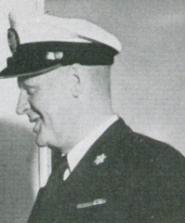
Capt. Stuut on a photo from 1947
Captain Teunis Stuut.
(Also spelled as Teunes or Theunis by the company)
Born: Dokkum, 7 October 1890. Religion: Dutch Reformed.
His father was Lieffert Stuut and he operated the best known hotel in Dokkum which had been in existence in one form or the other for 400 years. Known in those days as Hotel Lijbering he was in charge from 1904 to 1911. His wife’s name was Lotje Hitman and together they raised a family of 8 children.
By the time Teunis Stuut joined Holland America his father was recorded in the company archives as having passed away. (*) Currently the Hotel is called “The Posthoorn” which translates to “The Post man’s Bugle” (or horn) and is still in operation. (a,b,c)
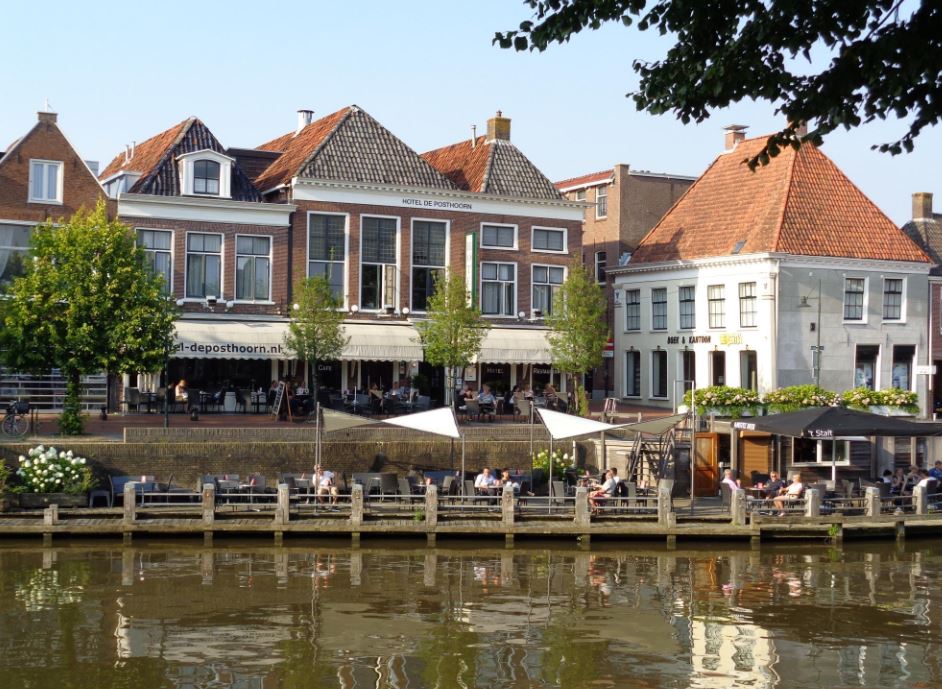
Hotel De Posthoorn in Dokkum. (I googled this of the internet and there was no creator listed)
Captain Stuut went to the Maritime School on the island of Schiermonnikoog. Most likely to this school on this island because his mother came from there (c) , so there was probably family he could stay with as there were plenty other Navigation Schools in the area. But not close enough to be able to remain at home. How he came to the decision to go to sea is not known, he most likely followed in the family tradition as most Stuut’s were seafarers. It sort of ran in the family for generations already. A Mr. / Captain Geuchien Willemszoon Stuut was mentioned in 1836 in a Note of Protest inregards to a load of Rape See being damaged by sea water on board his sailing ship :De Veerenigde Frouw”. This Gentleman surfaces again in November 1839 when he marries (in the town of Wildervank) with Anna Margarethe Lieferts Eerkes. (In the Act of Marriage is noted that his father was Willem Geuchienszoon Stuut (deceased on 04 April 1830 in Zaandam) Thus the Great Father of the Captain was also a Skipper or Captain.
In 1841 Geuchien W. Stuut shows up in the records as owning the ship Anna Margaretha named after his wife. These two turn out to be the Grand Parents of Captain Stuut. (I)
The father was Mr. Lieffert Stuut. We know this as there an temporary Act of Birth made up by the Dutch Consul in Rio Grande do Sul that on 14 March 1885 Lieffert Jr. was born. Being the oldest brother of Teunis Stuut. The father is listed as being a ships captain living at Wildervank in the Province of Groningen. He was noted as not being present at the birth of his son but at sea. Father then comes ashore maybe after his ship has ran ashore (20 April 1886 at Tracaty) and then he buys a club in Dokkum in 1887 called the “De Harmonie” or in Dutch, a Societeit. Do not think in terms of posh bankers visiting there, this was for the ordinary worker who could meet and socialize with fellow workers. He sells this place in January 1903 and buys in February 1903 Hotel The Posthoorn, see above. Thus Teunis Stuut was born in Dokkum while his father was the proprietor of this Club / meeting House. (I)
For more info about the ships see (h). The name of one of the ships Anna Margarietha continued in the ladies Lineage of the family for quite some time.
The father (Henrik Hitman) of his mother was listed as a sailor and later mate on the sailing ship of Lieffert Stuut. There are two attests signed by Captain Lieffert Stuut who recommends him first as sailor and later as 2nd Mate. The daughter had been on the ship when the oldest son was due, and delivered him ashore in Rio Grande do Sul. (c) (Editor: In those days of captain/owners it was not usual that the whole family was on board and sailed with the ship until the childeren reached the school going age)
The oldest brother, Lieffert Stuut (jr) (see above as born at Rio Grande) also went to sea and was mentioned as captain of ships called the Waterland and Kennemerland (KHL or Royal Dutch Lloyd) in the newspapers in the 1920’s. Both ships made a number of charter voyages for the Holland America Line to South America so it is very well possible that both brothers sailed/worked for the same company at the same time.
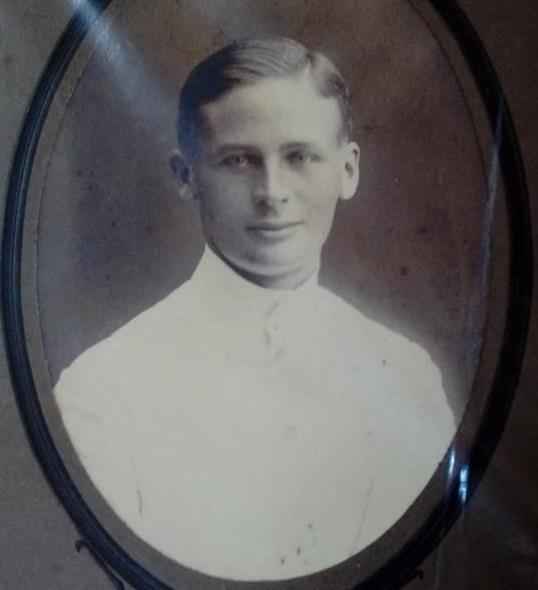
This photo is labelled Bandoen Indonesia 1918. and must have thus been taken when he was there with the ss Zaandijk (c)
(*) Although not part of this biography, the story is too good to miss. In 1908 Mrs. Stuut the mother passed away. Then in 1910 the hotel goes up for sale, the newspapers mention foreclosure, and Father Stuut emigrates to Argentina. ( to Patagonia) with 2 of his sons. Here the government handed out land for free as long as it was cultivated. After some years, (if you payed the taxes) the land would become yours. Together with his sons then ran an Estancia in Patagonia and he died there. Why he went to Argentina is not known by the family but the historical websites give other Stuut’s who emigrated in the same way in the 1860’s. The Estancia still exists and is run by one of his descendants. (c) Historical records show that the Dutch Government actively promoted emigration both to North and to South America. Each time in the periods around the World Wars. So if the entry in the company records is according to the truth, then the Dutch Government must have closed the books on him and had him officially declared death.
After school he sailed as cadet for 1.5 years with the shipping company of Jos de Pooter (cargo tramp services) based in Rotterdam. He then obtained on 22 march 1910 his 3rd mates certificate and returned to the same company. There he sailed until October 1910 as 3rd officer and then later as 2nd officer. There is a family photo of “The Draft 1911” which show a young Teunis Stuut among a group of soldiers. This ties in with the fact that on 09 Aug. 1914 (when an invasion of the southern Netherlands by Imperial Germany, was possible, as they were looking for a short cut int Belgium and from there to France) he was called back to his regiment for the General Mobilisation of the country.
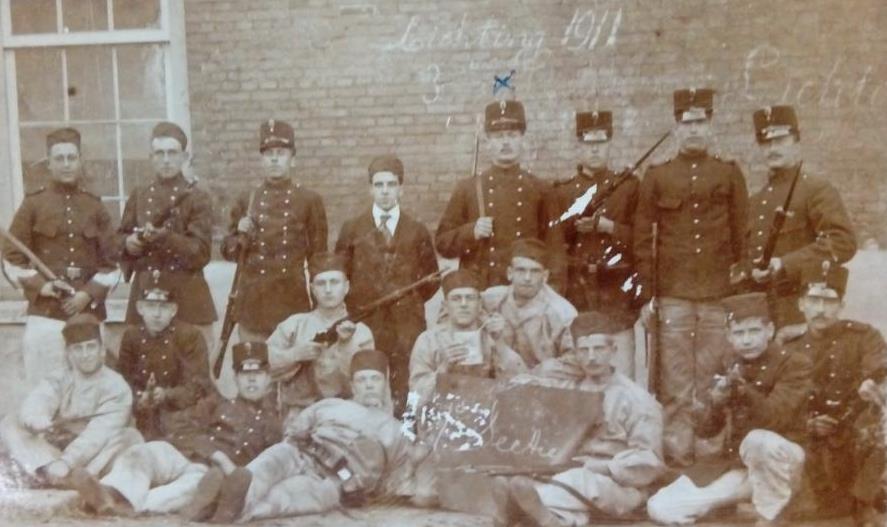
In the army. (c) On the back wall there is in crayon written “Lichting 1911” which translates into the “Draft of 1911”, Future Captain Stuut is in the back row with a cross above his cap. It looks like it that the uniform availability left some room for improvement. Because of his 1911 training he was recalled in 1914 for the General Mobilisation.
Went back to school in Rotterdam until 04 February 1914 when he obtained 2nd mates license. The then switched companies and joined the HAL. Holland America had been expanding since 1909 and that created gaps in the manning, especially for officers with higher licenses and thus it was possible that he was slotted in sideways in 1914.
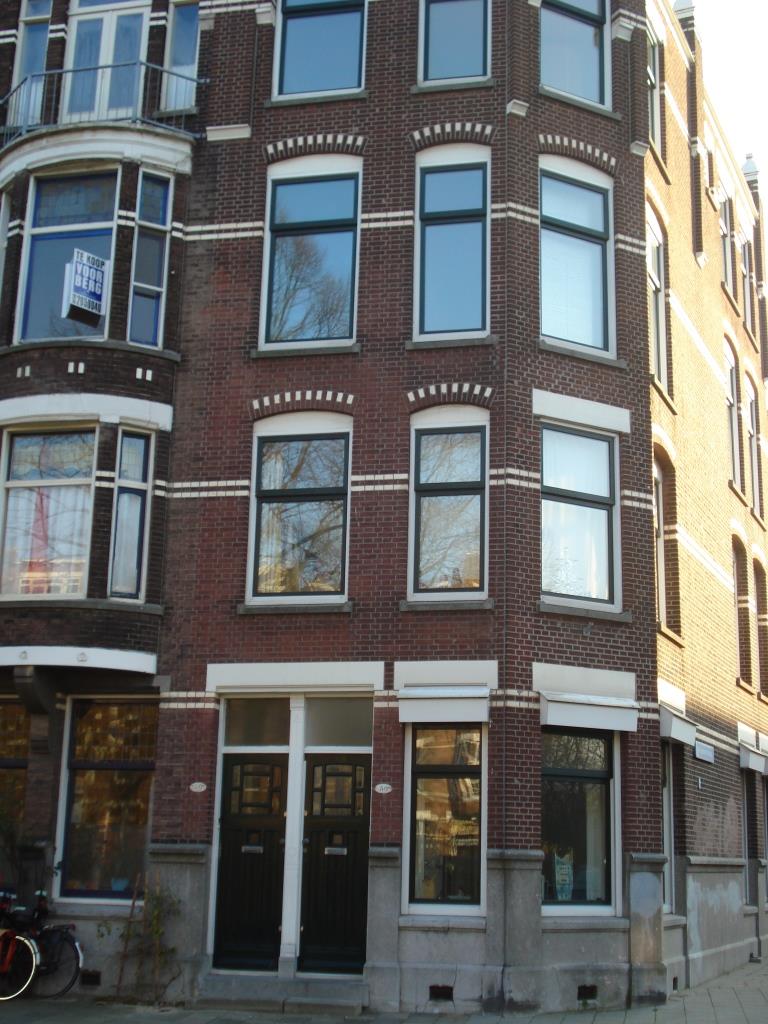
In the big cities of Holland living in apartment buildings was quite normal, and this is apartment where his family lived during the 2nd World War. (c)
He married on 18 November 1920 Miss Alberta Schutte (Daughter of Gerrit Jan Schutte and a Lady of Indonesian descent born in 1898 in Meester Cornelis Dutch East Indies and they settled down in Rotterdam. (During WWII at Bergschelaan 180b) She passed away on 10 June 1947 (i)
An allotment of Fl 200,– (weekly/monthly) was issued. Eventually there were two children, a daughter Thea and a son Gerrit (who had no descendants). Thea married Arthur Hendricks and emigrated to Argentina after WWII. They had a son called Tonny who had a daughter called Pauline Hendricks. Both are mentioned in the credits as they provided most of the photo material as there is very little in the archives or in the public domain.
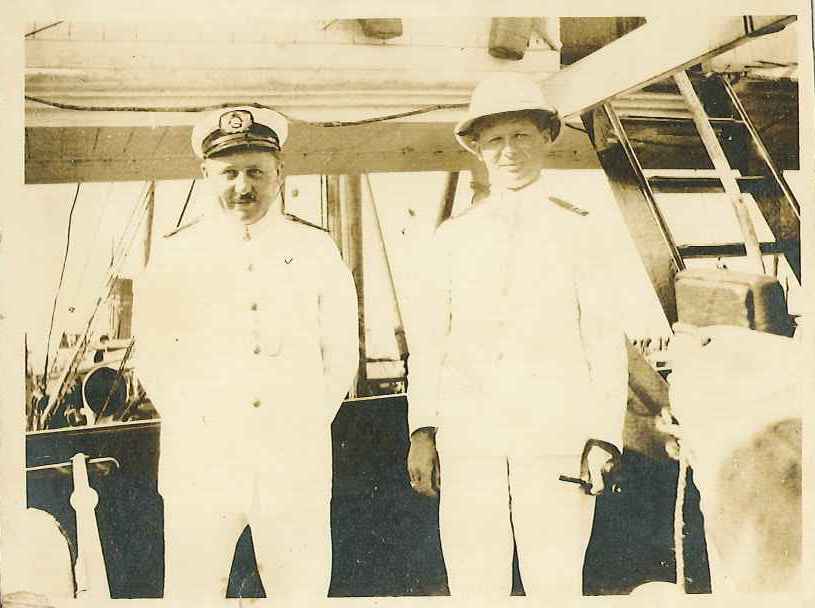
Editor: I think this is a photo from around 1924 when he was sailing with Captain C.J de Kup on the Sommelsdijk (II) Note the helmet for the tropics. This was a standard part of the uniform outfit when assigned to the tropic routes. This ship was for years assigned to serve on the Far East -British India Line which went as far as Ceylon and Madras. (c)
By 1918 he had been promoted to Chief Officer and was then stuck in this rank until 1935 as the depression set in, by the time he came close to promotion and the company was laying ships up and people off. Due to the fact that he had a family and was senior in his rank, he kept his job. Between 1935 and 1938 he does do fill in’s as Acting Captain until full promotion in 1938.
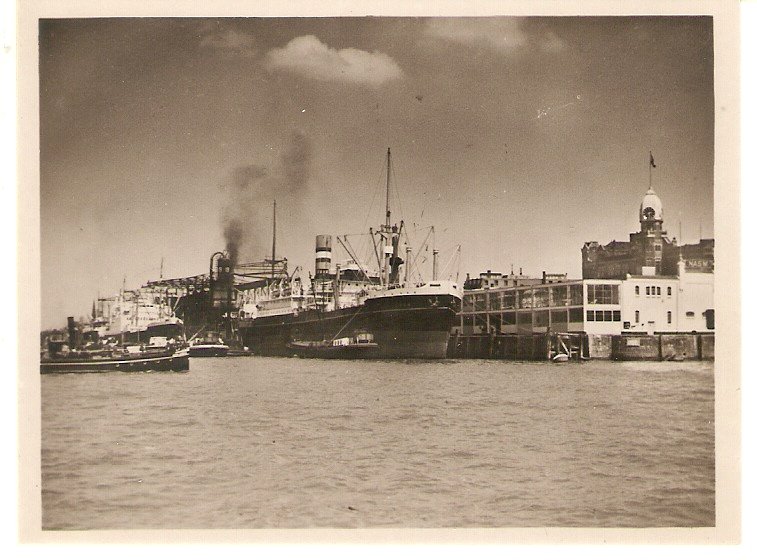
The ss Edam (IV) seen here at the Wilhelminakade at Rotterdam. Captain Stuut was several times in command of her.
Captain Stuut was on the ss Edam in 1940 when the war broke out. He had just taken over as captain for voyage 75 which left Rotterdam on 07 March 1940 and called at Antwerp, New York, Norfolk, Boston, Baltimore and Philadelphia. The ship the made the return crossing to Europe arriving at the Downs (South England) on 29 April for inspection. All neutral ships were required to anchor there so the British could inspect the ships to ensure that they were not carrying anything that could help the enemy. The ss Edam was still there when the war broke out so she did not make it back to Rotterdam but joined the war effort. It then spend most of the war on the USA – Europe shuttle (NY – Halifax – Glasgow – Liverpool).
Captain Stuut did not remain with her for long but was transferred to various ships throughout the war. A large percentage of that time was spent on ships in the Pacific War Theatre. Thus there was the ms Noordam and the flagship the ss Nieuw Amsterdam. Although it was war time, the company still tried to adhere to their pecking and rotation system of hopping ships when seniority increased. This resulted in a peculiar situation for Captain Stuut and also for the company.
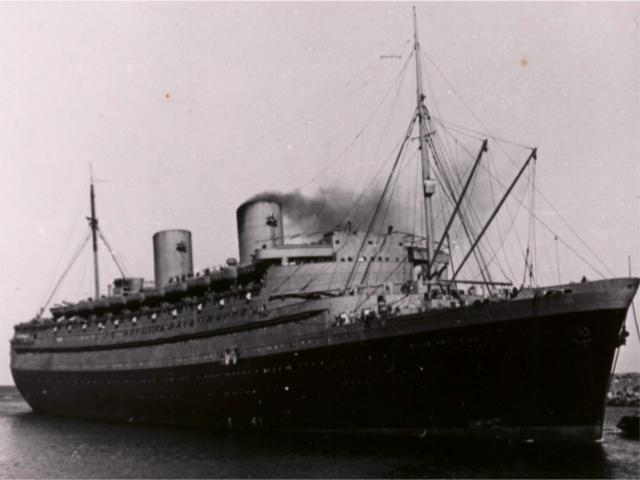
The ss Nieuw Amsterdam (II) This photo was taken around 1942
After the ms Noordam he was assigned as Staff Captain to the ss Nieuw Amsterdam, for which he traveled as passenger on an American ship called the ss Kansas. A Staff Captain rank on the Flag ship was considered being on par with that of a captain on the cargo ships. With the seniority rotation in the fleet that also worked in the way that once you had made it as Staff Captain to the flagship, you were then promoted to the most junior cargo ships and then started working your way up again. The idea of just promoting somebody on board the Nieuw Amsterdam to Staff Captain was not considered an option; and thus did he have to travel from New York via Pernambuco (South America) to Cape Town and from there by train to Durban.
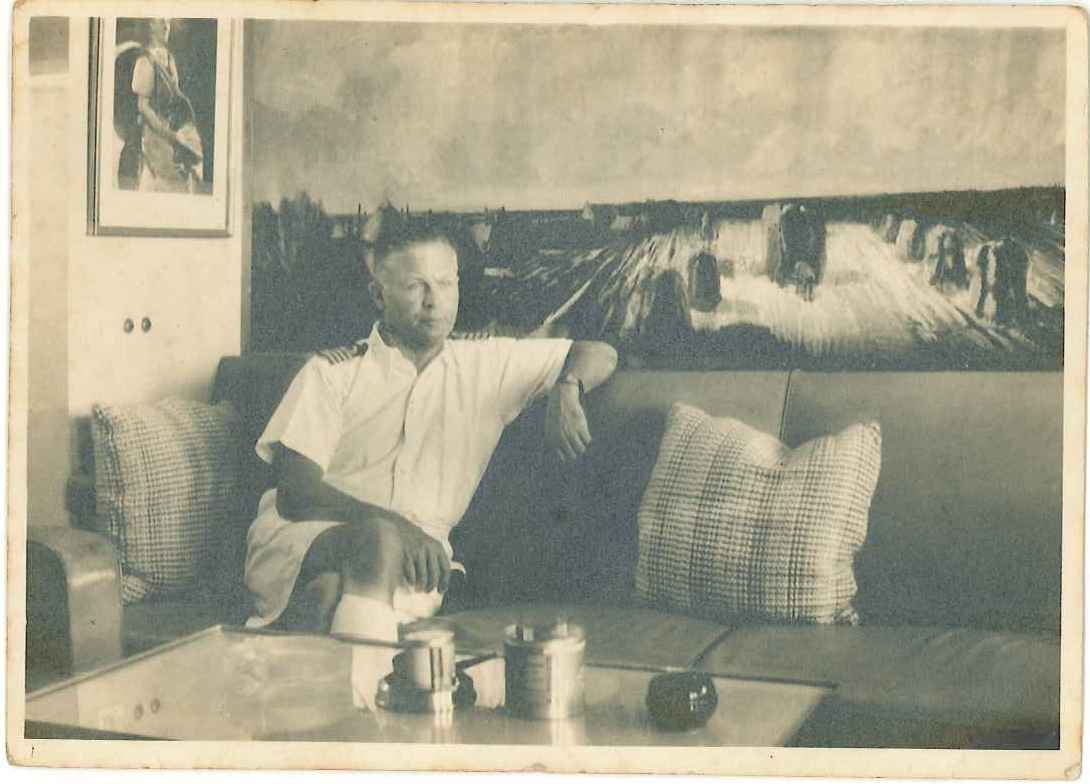
As captain on board the ss Nieuw Amsterdam (II) (c)
Still the careful planning of the company did not completely work out as with the retirement of Captain/ Commodore Bijl on the Nieuw Amsterdam there was a gap. This was temporary filled by Captain Wepster but when he had to leave Staff Captain Stuut was promoted to Master of the most senior ship in the fleet. The assignment lasted for close to 3 months and then the new commodore, Captain Barendse, arrived and took over. Stuut stepped back to Staff Captain until he could transfer in Cape Town and went to the ss Edam as Captain.
From ss Edam he goes to the ms Delftdijk, only serving for short periods on both ships, and then he ends up on the ms Sommelsdijk (III) where he will remain for two years. He was now on a ship where he sort of belonged according to his seniority level in the pecking order. On this ship he gets the experience which will make him immortal in Hal history and which also creates a very usual episode in the history of the Dutch Merchant Navy during the 2nd World War. I can only give a short compilation of what happened here but there is a booklet out in the antiquarian world, written from the perspective of the US Doctor on board, which gives a good idea of what took place even if the captain is hardly mentioned. See title at the credits at the end. (d)
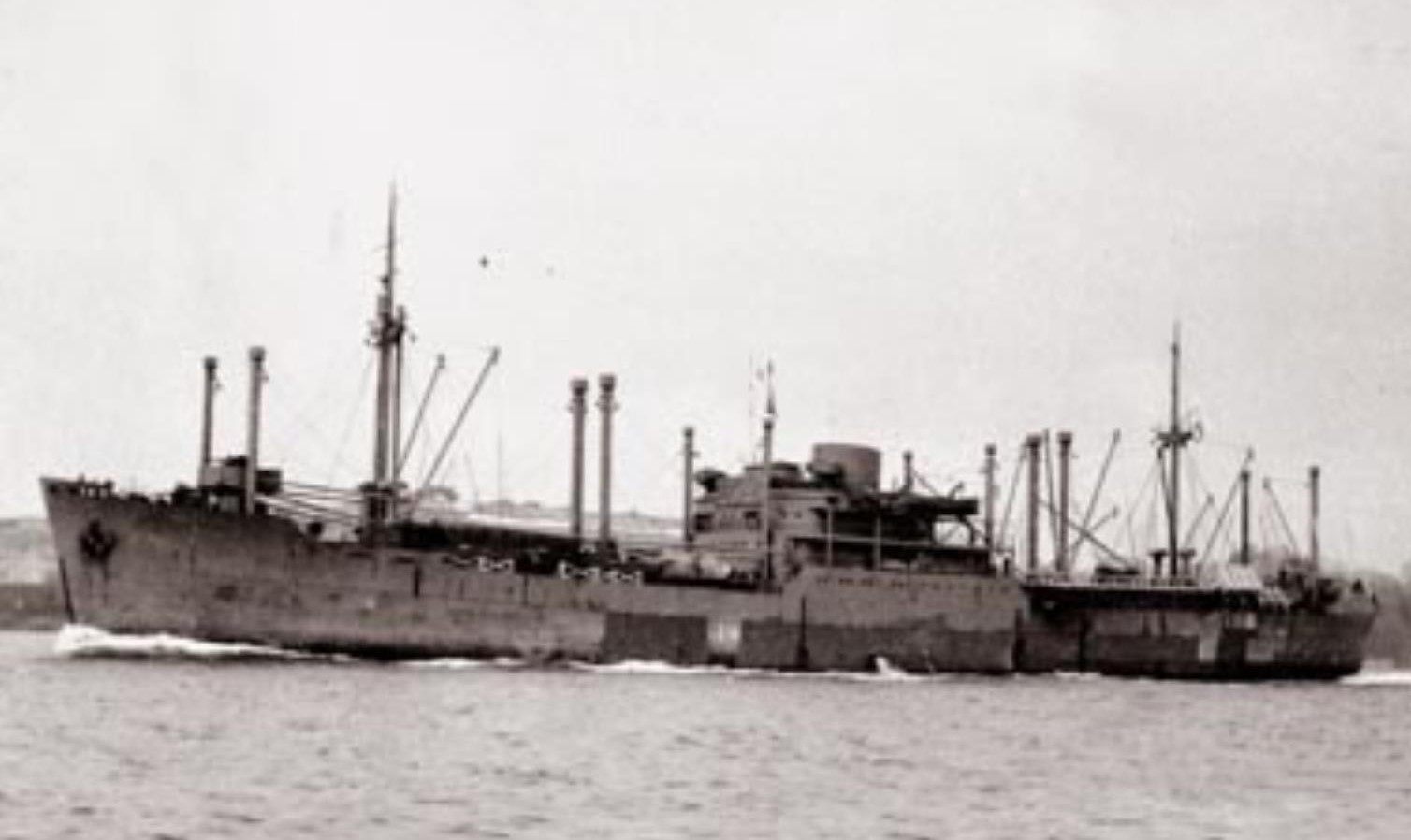
The ms Sommelsdijk (III) In war time grey and under full speed. She and her sister the ms Sloterdijk (II) had been built just before the war started. They had a limited Passenger accommodation for 12 passengers and often carried important people as they were quite fast, being twin screw, had luxury accommodation and were considered to be able to out run torpedoes.
For those who do not have any command experience on ships: what Captain Stuut pulled of is sort of comparable of driving a lorry at full speed with a blown tire on a slippery road down the mountain and making no mistakes in the assessing the safe turn around the next corner.
The voyage of the ms Sommeldsdijk started in San Francisco on 17 November 1944 when the ship boarded 1413 troops, mainly Seabee’s (soldiers specialized in landings /invasions from the water by landing craft) and then sailed for Milne Bay and to Hollandia to land some of the troops. 26 Officers and 1266 troops continued the voyage (in a slow convoy) to Leyte on Guam. Op 26 December in the early evening the ship is attacked by an air torpedo launched by an enemy air plane (which underestimates the distance to the water during its attack dive, hits the water and disintegrates) This torpedo hits the ship under water near hold nbr.1 and explodes; causing flames to erupt from the hold and debris to be showered all over the ship. Also in hold 1 there is ammunition stored and the ships complement immediately put the fire hoses on the hold for cooling and jettisons the rest of the ammo.
The Captain has the engines started and then moves slowly to the beach in case the ship would sink. Then the anchor is dropped again without realizing that there is now a soldier hanging at it, who was blown over board. Soldier and anchor hit the bottom but then he is picked up without being much worse for wear. The navy ships HMAS Gascoyne and USS Buttonwood come to the rescue and help dosing the flames which takes the whole night as now holds 1,2 and 3 are affected. The troops are shuttled ashore with lighters. In total 6 soldiers died in the explosion and subsequent fire.
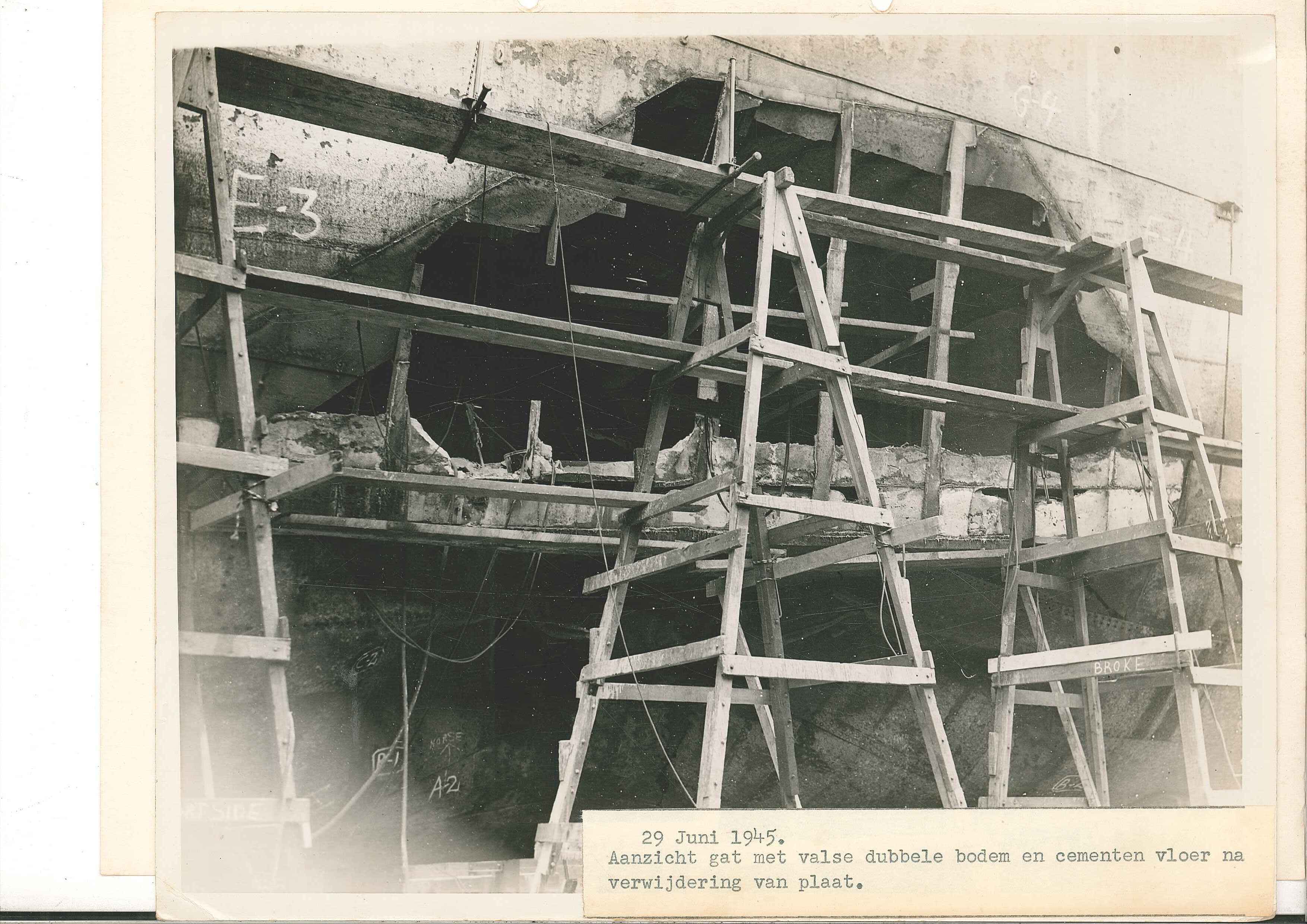
The hole blown into the ships hull by the air torpedo. The Dutch text reads: View of the false double bottom and the cement flooring after removal of the steel plate (g)
With the aid of a salvage vessel a start is made to pump the water out of the holds again and the cargo is being discharged to shore. Cement is used to close the hole and (by now it is the end of January) as a steel repair does not work due to the steel hull plates having been pushed too far inwards. This was was accomplished by 22 February and then the ship slow steams to Hollandia. On this stretch of the voyage bad weather was encountered which affected the repairs and it forced the ship to return. By March 14 repairs continue in the port of Tacloban and the ship is ballasted over the stern to get the bow above water so the hole could get a temporary steel plate cover and then the inside area filled up with cement. The captain notes in his voyage report that the long waiting period did not adversely affected ship’s discipline as there were no food issues as they were helped out by the ms Noordam and the ms Klipfontein.
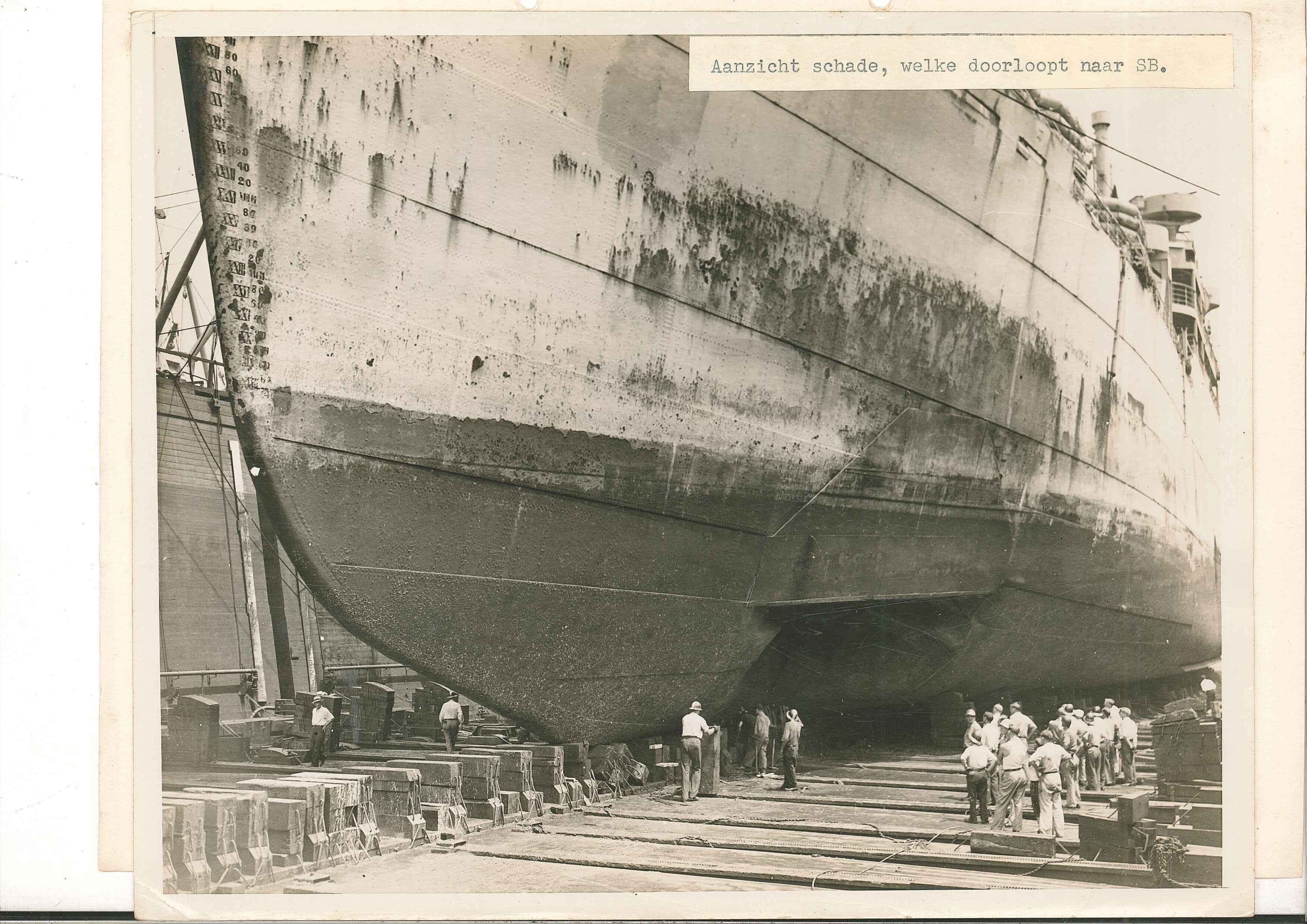
Once the ship went dry in New York, the size of the hole became clear. The Dutch Text reads: View of the damage, which continues to the Starboard side. (g)
On 18 April the USCG gave approval for the sailing to New York (Route: Tacloban, Hollandia, Langemak, Funafuti, Panama Canal, New York) which voyage commenced on 23 April. On Departure there is a lot of fuss by the various authorities over the fact that the ship does not have a Certificate of Seaworthiness. (The USCG Officer who had approved the sailing said he could not issue such a certificate to a foreign flag ship) Eventually this is solved by the Royal Dutch Navy by advising the captain that he can issue his own Certificate of Seaworthiness. Captain Stuut sees no problem just doing that and thus sails. The hole is not completely closed and the engineers have to keep the pumps going watch after watch. The ship stops at Funafuti to land a wounded gunner (fell from the stairs) and then sails on to Balboa. The water level in the holds can be kept constant. By 14 June the ship arrives at the Panama Canal. From here it proceeds without too much of a problem to New York where it arrives on the 30th of June. Final repairs are made at Todd Ships yards an undertaking which last until September. (c.d.e)
On this epic voyage of over 5 months, The Sommelsdijk covered a total distance of approx. 12,000 nautical miles from Leyte to New York. Sailing in various kinds of weather, which needed careful ship handling to ensure the hole in the hull would not get worse, the temporary repairs would continue to hold and thus the water level could be controlled with the pumps. (Editor: As far as my knowledge goes, this 12,000 nautical miles is the longest journey ever made by a holed/damaged cargo ship under own power.)
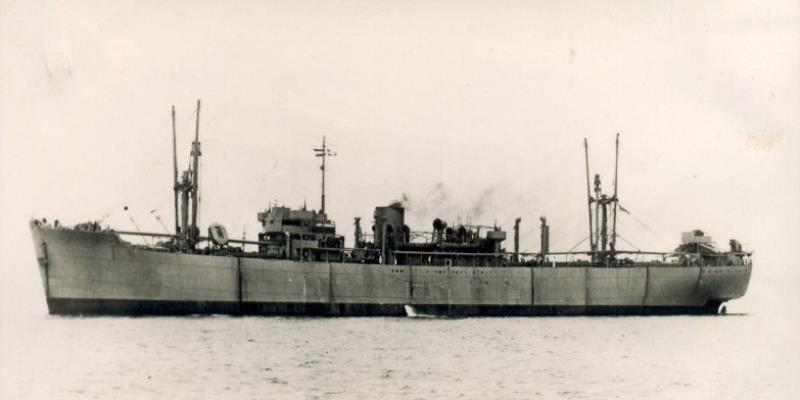
The ss Phlips Wouwerman. This ship did not belong to Holland America (hence no DAM or DYK name) but was managed by the company between 1943 and 1946.
Captain Stuut leaves the ship here to go on a well-earned vacation of three weeks and then takes command of the cargo ship Philips Wouwerman. (Note: There was no reason from him to stay with the Sommelsdijk as with dry docks in those days all the work was done by the Staff Captain and the Chief Engineer. The captains transferred or were given a (short) vacation) With the Philips Wouwerman the captain returns to the Netherlands where he arrives on 27 July 1945 after having been away since 07 March 1940.
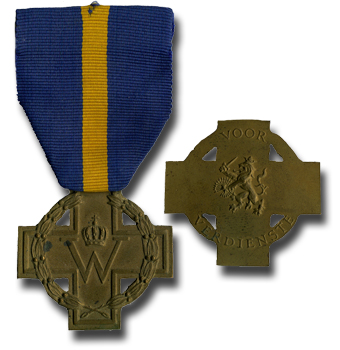
The Dutch Cross of Merit. Issued from 1941 onwards until the current day. (From Wikipedia)
As the war has now ended, the Dutch Government starts to issue medals and other forms of recognition to those who had given their lives in the line of duty or had made outstanding contributions to the struggle for freedom and man kind.
For his expert navigation of the Sommelsdijk to a safe port for dry docking and repair and excellent leadership in other commands, he received the Dutch (Order) Cross of Merit as announced on 19 Oct. 1945 The Cross of Merit is the fourth-highest Dutch military decoration and still being awarded for bravery.
The medal was officially handed out by Queen Wilhelmina on 04 April 1946 at her Palace “Noordeinde” in The Hague. Captain Stuut and his wife were part of a larger group of Dutch Merchant Navy Captains, Officers and Crew who were receiving medals. Some of the Captains who had fallen in the war were represented by their families.
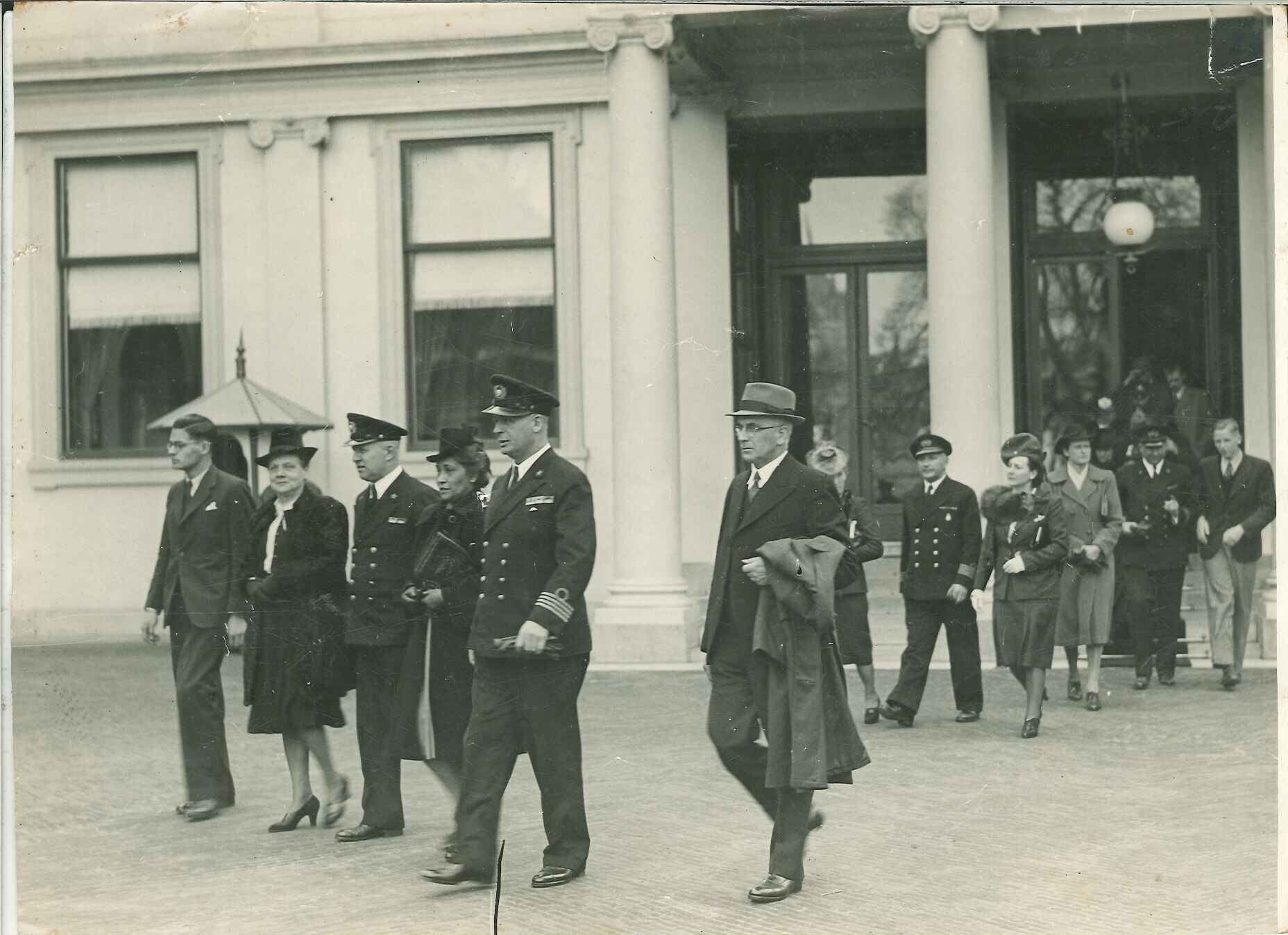
While leaving the Royal Palace after receiving the Cross of Merit. Captain Stuut is 2nd from right on the first row. The Lady next to him is his wife Anna.
In due course he also received:
War Memorial cross (number 285024) with
- bar (general war service merchant navy 1940 – 1945)
- bar (special war service East Asia – South Pacific 1942 – 1945) (see above)
- Pacific (Merchant Marine) War Zone Medal issued by the USA
- Atlantic (Merchant Marine) War Zone Medal issued by the USA.


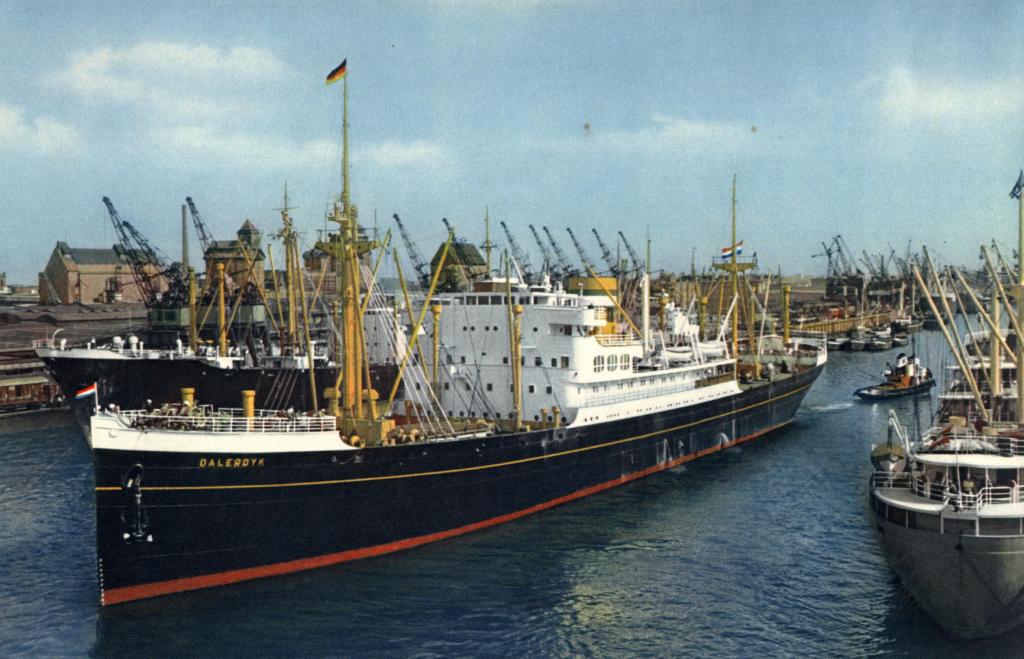
The ms Dalerdyk. Seen leaving here from Hamburg was employed on the Rotterdam to Vancouver (North Pacific service) but also called between Rotterdam arrivals and departures at Hamburg and Bremen to collect German businessmen. As the ship was considered to have the best passenger -cargo accommodation around 1950, she was very popular.After the war, the rotation over the fleet continued and thus he went from ship to ship and by 1949 he was given command of the ms Dalerdijk which was the completely rebuilt Damsterdijk from before the war. This ship had been seized by the Germans in 1940, and had been partially burned out in Kiel 1945. Still the engine room was found to be in reasonable order and thus the ship was repaired but also renamed due to the amount of changes affected on it.
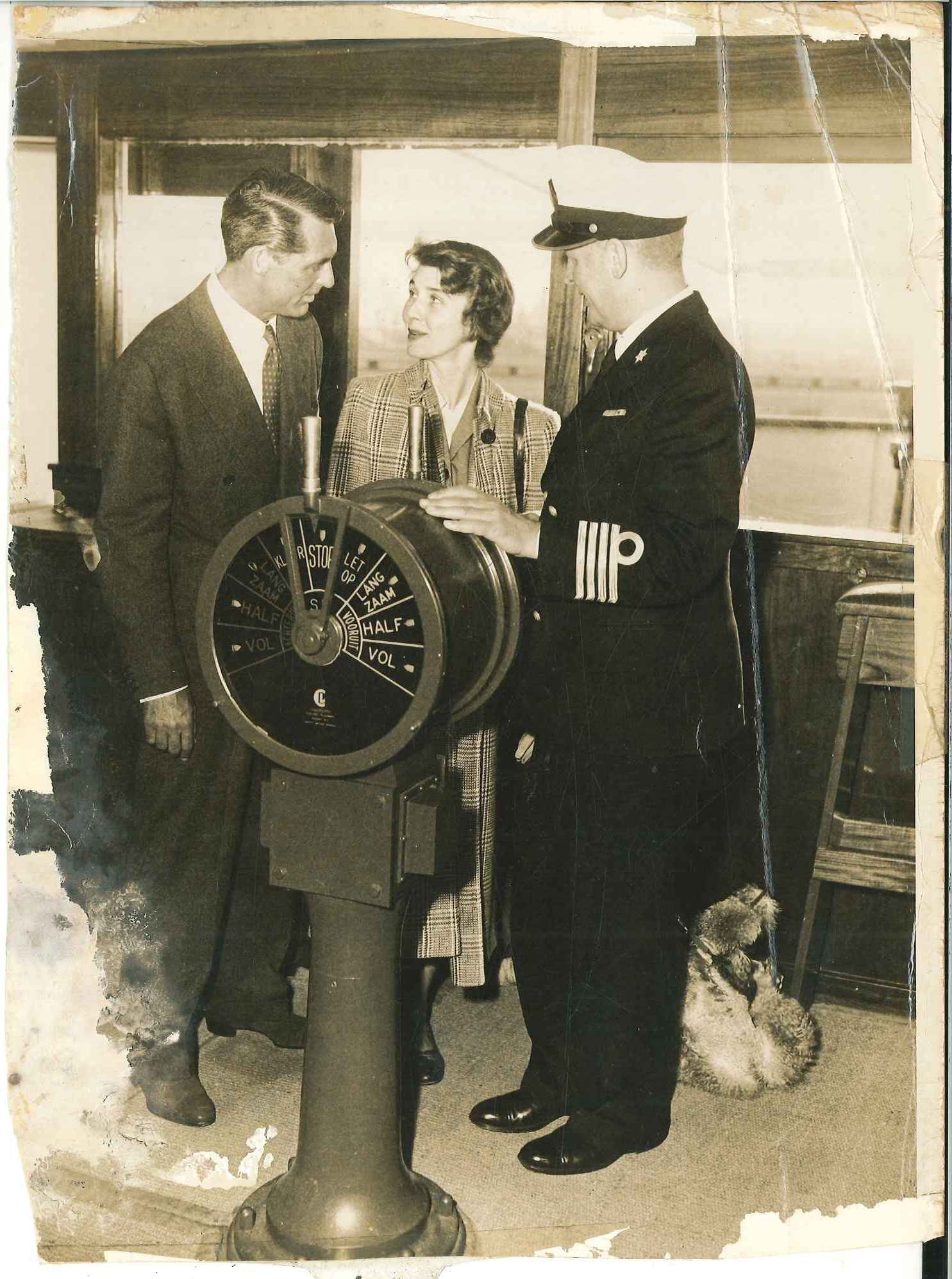
31 March 1949 Los Angeles. From left to right Cary Grant, Betsy Drake, Captain Stuut, Dog. (c) Betsy is looking very much in love with her friend and indeed the two married later, although the marriage did not last.
During the 2nd voyage of the ship from Rotterdam to Vancouver he gets a bit of glamour on board by the means of the movie star Gary Grant, who is sailing with the ship from Antwerp (March 10) to Los Angeles (March 31) 1949. He sailed by himself and the Dalerdyk had been chosen by Betsy Drake because Grant was recovering from Hepatitis B and the Dalerdyk was known to have very good radio equipment on board for long range medical advice if needed. She came to pick him up, with dog, on arrival Los Angeles (And befitting a movie star with a photographer in her wake) Although the ship might have been an excellent choice, the weather for the entire duration of the voyage was very bad and thus, apart from recovering from his illness he was also confined to his suite due to the movement of the vessel. He was accompanied by a doctor, Mr. Chato, who wanted him to put at least 20 pounds back on, which he had lost during his illness. The weather did not help very much to achieve what Holland America Line food could have done.
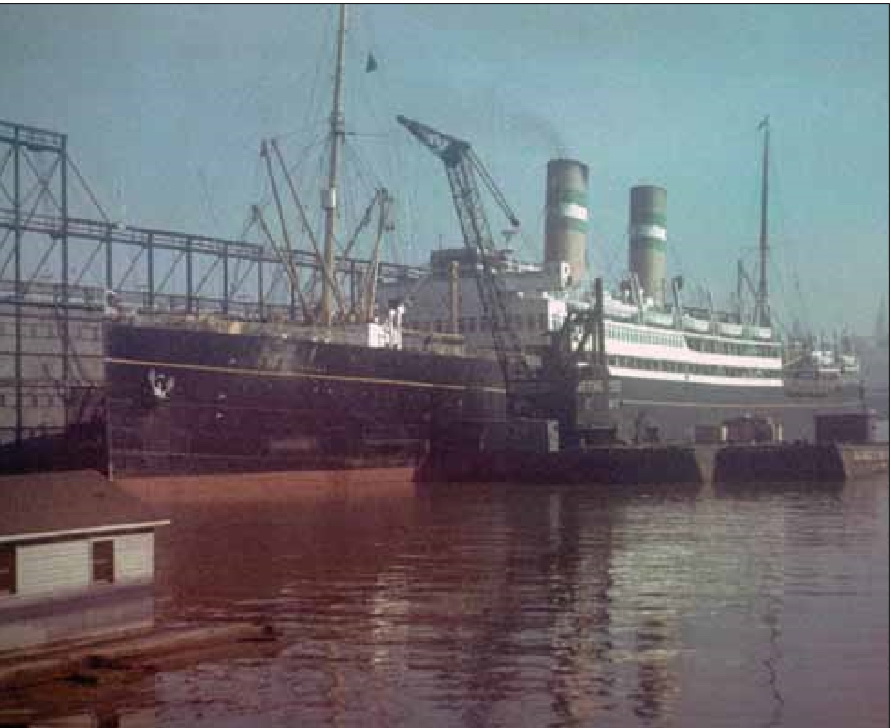
The ss Volendam (I) This photo was taken around 1950 at Hoboken and is one of the very few color photos that exist. (g)
From the ms Dalerdyk he is transferred to the ss Volendam, after the flagship the highest ranking ship in the fleet. The ss Volendam maintained a regular liner service but was on occasion also involved with carrying emigrants. During voyage 218 , April 1950 the ship landed 1260 Dutch Emigrants at Pier 21 in Halifax. On return voyages the HAL ships were often full with students who went to Europe as at that time, with the strong dollar, Europe was good value; even for a poor American Student.. Holland America had a special organisation called the STCA which focused on these student trips. Students went either for study or for a summer round trip through Europe and the company would issue them with a booklet (Titled: Hand me Down) which gave all the good price hotels, restaurants and other things a Student wants to know, see and do. All the information was based on the experiences from the Students themselves from the year before. A sort of early Trip Advisor. The STCA lasted from 1928 until 1966. (Editor: At least that is the last year of issue of the booklet that I have in my collection)
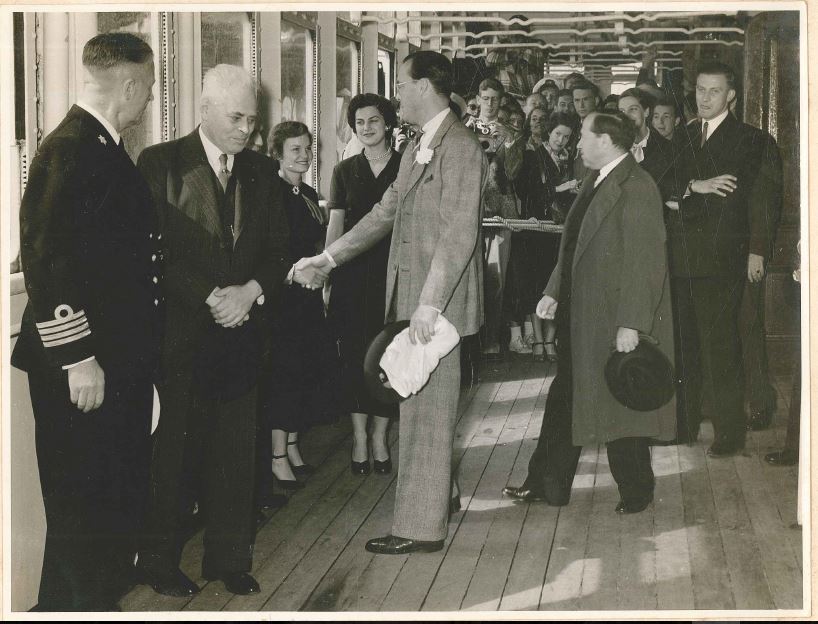
On arrival Rotterdam (04 August) with another full load of students, Prince Bernhard, the Prince Consort of Queen Juliana of the Netherlands came on board to welcome the students to the country. This was voyage 221 of the Volendam which called at Halifax to land 628 emigrants and then on went to New York to board the students. Next to the captain, (Gentleman with the white hair) is the Burgomaster of Rotterdam J..P. Oud. The others are the teachers / escorts from the NSA which organised these tours together with the NBBS (Netherlands Office for Foreign Student Relations)
Captain Stuut retired on 16 January 1951 after ending voyage 223 of the ss Volendam. He never made it to the flagship as the pecking order did not allow for that. Colleagues of the same age, who had joined Holland America before him, were first in line. But he retired from the ss Volendam which was by company standards after the flagship the next best thing. He had spent 43 years of his life at sea of which 37 years with Holland America.
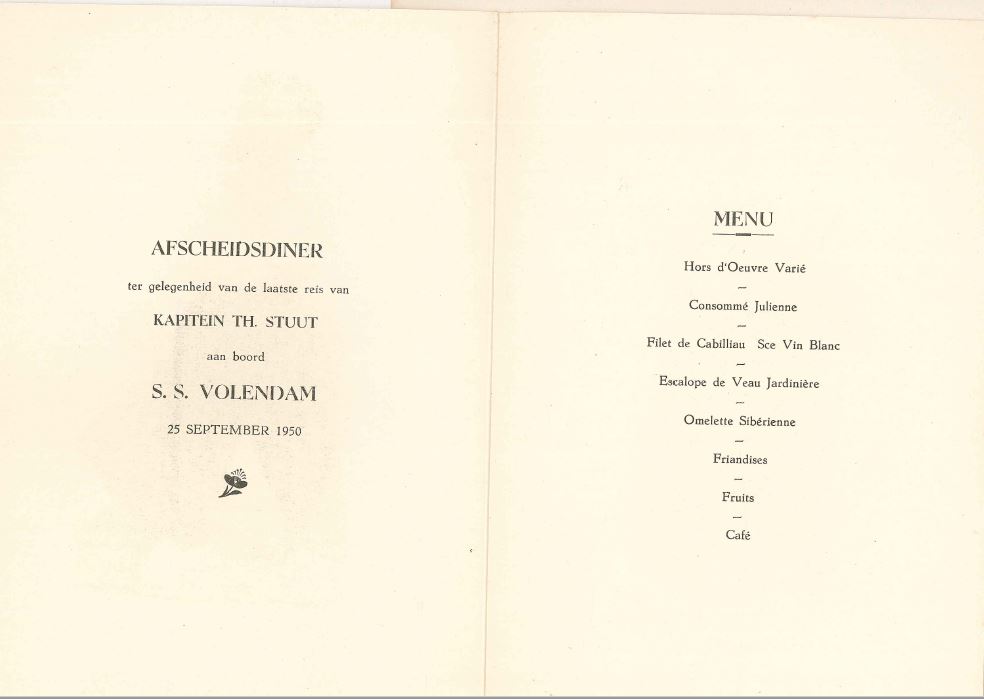
Fare well Dinner menu dated 25 September 1950. As was standard with HAL around that time, the first class menu’s were in French.
He passed away on 24 Jan. 1962 in Rotterdam. I have no information about his family life apart that he must have taken a keen interest as there are the photos to prove it. (Will be posted once a good quality one has been forwarded by the family)
Credits:
- (a) By Google.
- (b) Holland America Line Archives as held by the Municipal Archives of the City of Rotterdam
- (c) Mrs. Pauine & Mr. Ton (Tonny) Hendricks, Argentina
- (d) Book: With the Sommelsdijk in the Far East. Ellwood Paul M.
- (e) De Geschiedenis van de Nederlandse Koopvaardij in the Tweede Wereld Oorlog. K.W.L Bezemer.
- (f) Carry Grant a biography. Marc Elliott (page 269)
- (g) Photo via Mr. Donald van der Horst.
- (h) Dutch website: https://www.marhisdata.nl/eigenaar&id=35303
- (I) Mr. Laurens van der Laan, Holland America Line Historian.
- All other photos from Authors Collection.
Career listing: (until 1937 from HAL Archives, then various sources)
Date: Function: Ship: Wages, ending dates of contract, and/or remarks.
24 Feb. 1914 3rd. Officer Soestdijk 60,–
09 Aug. 1914 Temporary ashore for the mobilization
23 Oct. 1914 2nd Officer Zaandjk 100,–
26 Jun. 1915 2nd Officer Zaandijk 110,–
26 Oct. 1915 2nd Officer Maasdijk 110.—
28 Apr. 1916 2nd Officer Maasdijk 120,–
11 May. 1916 2nd Officer Zaandijk 120,–
12 May. 1916 2nd Officer Maasdijk 120,–
11 Sep. 1916 Temporary dismissed to study for first mates license
23 Dec. 1916 Rejected for 2 months
23 Jun. 1917 Passed exam for first mates license
26 Jun. 1917 2nd Officer Maasdijk 120,–
19 Jul. 1917 2nd Officer Maasdijk 130,–
07 Jan. 1918 Chief Officer Zaandijk 140,–
01 Oct. 1918 Chief Officer Zaandijk 150,–
01 Apr. 1919 Chief Officer Zaandijk 160,–
01 Jul. 1919 Chief Officer Zaandijk 280,–
01 Jul. 1920 Chief Officer Westerdijk 290,–
07 Nov. 1920 Ashore and getting married. On leave for 2 months and 11 days.
18 Jan. 1921 Chief Officer Soestdijk 330,–
27 Jun. 1922 Chief Officer Binnendijk 305,–
26 Sep. 1922 Chief Officer Westerdijk 305,–
10 Nov. 1922 Temporary ashore
05 Dec. 1922 Chief Officer Bilderdijk 305,–
26 Jan. 1923 Chief Officer Breedijk 305,–
26 Jan. 1924 Chief Officer Sommelsdijk 305,–
03 Jul. 1924 Ashore 305,–
28 Jul. 1924 Chief Officer Sommelsdijk 305,–
07 Jan. 1925 Chief Officer Blommersdijk 305,– with the train to Rotterdam.
08 Jan. 1926 Chief Officer Maasdam 305,–
08 Apr. 1926 Chief Officer Noordam 305,–
08 May. 1926 Chief Officer Boschdijk 305,–
12 May. 1926 Chief Officer Drechtdijk 305,–
31 Dec. 1926 Chief Officer Maasdam 305,– has Sperry gyro Certificate.
01 Apr. 1927 Wage increase 315,–
02 Apr. 1928 Chief Officer Nieuw Amsterdam 315,–
09 May. 1928 Chief Officer Ashore 315,–
21 May. 1928 Chief Officer Volendam 315,–
31 Dec. 1928 Chief Officer Rotterdam 315,–
01 Jan. 1929 Wage 325,–
28 Oct. 1929 Chief Officer Statendam 325,–
01 Jan. 1930 Wage 335,–
10 Apr. 1930 Ashore Due to illness 335,– Bronchitis.
05 May. 1930 Chief Officer Statendam 335,–
11 Apr. 1931 Ashore 335,–
18 May. 1931 Chief Officer Maasdam 335,–
19 Dec. 1931 Wage decrease 268,–
22 May 1932 Wage decrease 262,50 max wage acc contract.
29 May 1932 Temporary ashore at 70% 262,50
02 Jul. 1932 Chief Officer Damsterdijk 262.50
20 Feb. 1933 Chief Officer Volendam 262.50
24 Feb. 1933 Chief Officer Damsterdijk 262,50
28 Jun. 1933 Wage decrease with 5% in acc. with circulaire No 929 dated 27-6-1933
28 Dec. 1933 Wage decrease to 236.50 see circ. 929 dated 27-6-33
01 Oct. 1934 Wage decrease to 226,75
02 Aug. 1935 Temporary ashore 226.75 regular leave
02 Oct. 1935 Temporary ashore 70% 226.75
03 Oct. 1935 Chief Officer Statendam 226.75
27 Nov. 1935 Act. Captain Edam 226.75
03 Dec. 1935 Chief Officer Statendam 226.75
12 May. 1936 Temporary ashore 226.75
26 May. 1936 Chief Officer Rotterdam 226.75
25 Sep. 1936 Act. Captain Spaarndam 352,– at New York
20 Jan. 1937 Set back to chief Officer and temp ashore 226.75 cancelled
21 Jan. 1937 Act. Captain Binnendijk 350,–
25 Jan. 1937 Temporary ashore 350,– with the flu
27 Jan. 1937 Act. Captain Binnendijk 350,–
17 Apr. 1937 Set back to Chief Officer and temp ashore 226.75
12 May. 1937 Chief Officer Statendam 226.75
27 Aug. 1937 Taken ashore at Eudokia for appendicitis Operation on 31 Aug. On 70% Salary.
01 Oct. 1937 According the new regulation 225.25 at 70%
14 Oct. 1937 Temporary ashore 225,25
27 Oct. 1937 Chief Officer Veendam 255,25 End Date TBA
Gap for ending dates
30 Jul.1938 Captain Maasdam 04 Sep. 1938
07 Sep.1938 Captain Boschdijk End date TBA
Gap for ending dates
07 Mar. 1940 Captain Edam 04 Mar. 1941
16 Mar.1941 Temporary ashore for vacation 27 Mar.1941
27 Mar.1941 Admitted to Hospital ( 422nd Str. NY for operation. Discharged on 12 April 1941)
13 Apr. 1941 Continues vacation until 23 April, then placed in reserve pool
20 May. 1941 Captain Noordam 01 Oct. 1941
Temporary placed ashore and then ordered to join Nieuw Amsterdam as Staff Captain
22 Nov. 1941 Passenger on board Kansas 26 Dec. 1941
Sailed from New York via Pernambuco to Cape Town South Africa.
Joined ship on 21 Jan. in Durban.
21 Jan. 1942 Staff Captain Nieuw Amsterdam 01 Oct. 1942
(29 Jun 1942 – 23 July 1942 landed due to Herpes/Shingle diagnosed as Arthrosis-Deformaiis, then back on board)
02 Oct. 1942 Captain Nieuw Amsterdam 12 Dec. 1942 (While awaiting arrival of Commodore Barendse)
13 Dec. 1942 Staff Captain. Nieuw Amsterdam 15 Jan. 1943 Transfer in Cape Town to Edam, joins 26 Jan.
29 Jan. 1943 Captain Edam 29 May. 1943
05 Jun.1943 Temporary ashore for Vacation on 03 Aug. 1943
03 Aug. 1943 Captain Delftdijk 04 Oct. 1943
21 Oct. 1943 Captain Sommelsdijk 23 Jun. 1945
11 Jul. 1945 Captain Philip Wouwerman 27 Jul. 1945
arrives Home at the Family on 28 July. 1945
08 Dec.1945 Captain Edam 08 Mar.1946
31 May.1946 Captain Sloterdyk II 27 Feb. 1947
24 Sep. 1947 Captain Edam 11 Nov.1947
12 Dec. 1947 Captain Delftdijk 03.Dec. 1948
04 Jan. 1949 Captain Dalerdijk 24 Jun. 1949
31 Aug. 1949 Captain Volendam 16 Jan. 1951
Retired on this date after arrival Rotterdam.

February 16, 2020 at 1:46 am
He was my greatgrandfather! sailed with Cary Grant and other hollywood stars!
February 16, 2020 at 11:14 pm
Thank you for reading my blog.
I am in the process of finalizing the biography of Captain Stuut. So please some time in the near future check my blog again. If you have any (family) memories or photos I would love to know.
Best regards
Capt. Albert
March 28, 2020 at 1:31 am
I have plenty of pics!!!!whole albums…and some stories
Send me a mail
March 28, 2020 at 4:04 pm
hello! send me an email! i have plenty of pics
March 28, 2020 at 7:42 pm
Thank you
I will come from Captalbert1@aol.com
Much appreciated
Best regards
Capt.Albert